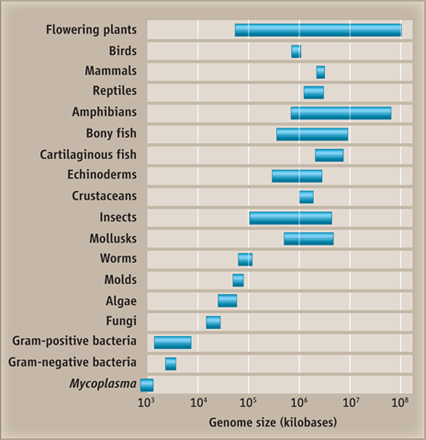
The "C-Value Paradox"
This chart shows the range of C-value [genome size,
measured as number of Kbp of
DNA] for a variety of organisms. So-called "simple"
prokaryotic organisms in general have less DNA per genome than do
more "complex," eukaryotic organisms, such as plants and
animals. The
so-called C-Value Paradox refers to the observation that
genome size does not uniformly increase with respect to
perceived complexity of organisms, for example vertebrate with
respect to invertebrate animals, or "lower" versus "higher"
vertebrate animals (red
box). Note for examples that some Amphibians have
more than 10-fold more DNA than
do Mammals, including humans.
There is in fact no "paradox." Evolution does not proceed in a linear manner, nor is there a linear succession of organisms from "lower" to "higher." Despite differences in DNA content, the number of genes in any vertebrate genome is roughly similar. Also, plant and amphibian genomes in particular are frequently polyploid, in which the chromosome number undergoes doubling to two-, four, or eight-fold. without a radical change to the form of the organisms.
There is in fact no "paradox." Evolution does not proceed in a linear manner, nor is there a linear succession of organisms from "lower" to "higher." Despite differences in DNA content, the number of genes in any vertebrate genome is roughly similar. Also, plant and amphibian genomes in particular are frequently polyploid, in which the chromosome number undergoes doubling to two-, four, or eight-fold. without a radical change to the form of the organisms.
Figure & Text © 2012 by Steven M. Carr, in NV Federoff (2012) Science 338, 758-767